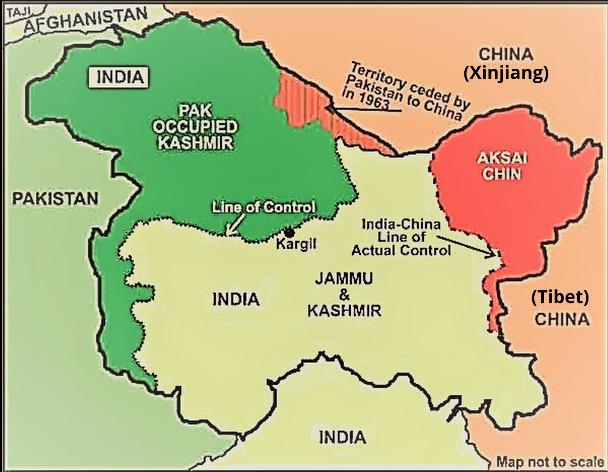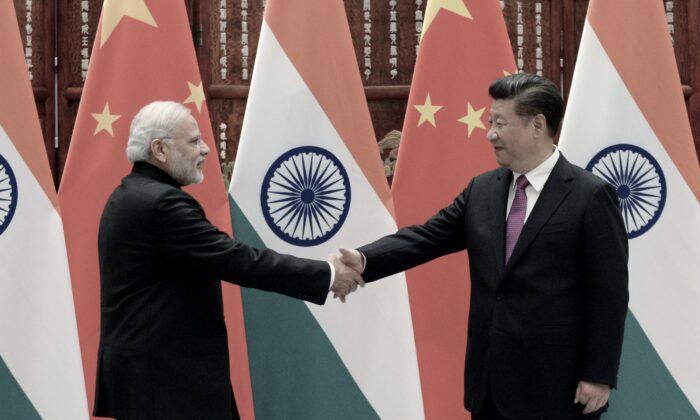NEW DELHI—A new Chinese law that empowers the “protection and exploitation of the country’s land border areas,” set to take effect on Jan. 1, 2022, is sparking a diplomatic war of words between India and China.
“China’s unilateral decision to bring about legislation which can have implications on our existing bilateral arrangements on border management as well as on the boundary question is of concern to us,” India’s Ministry of External Affairs said in a statement on Oct. 27.
However, the Chinese regime called India’s concerns “undue speculation” about “normal legislation” and said the new law won’t affect existing treaties between the nations.
Experts told The Epoch Times that India’s concerns are valid because the Chinese regime’s domestic politics are linked with its larger global agendas. India needs to be vigilant and not believe in what China says, as this law will be seen as a betrayal by India and is capable of making further talks and bilateral relations bitter, they said.
Chinese leader “Xi needs to show strength abroad, needs to demonstrate that he has regained lost territories before the 20th Party congress in 2022, and so, actions against Taiwan, India, in SCS [South China Sea], are all part of this,” Aparna Pande, the director of the Initiative on the Future of India and South Asia at the Washington-based Hudson Institute, told The Epoch Times in an email.
The law focuses on India, Bhutan, and Nepal and will have direct and severe consequences on India’s and China’s bilateral relations, Pande says.
“It will make any future rounds of border talks acrimonious,“ she said. ”Let us see if India decides to respond with any stronger actions on the economic front.”
How this tug of war further unfolds needs to be seen, she said, because India has applied to the Asian Infrastructure Investment Bank (AIIB), which is controlled by China, for a loan for vaccine production.
Tokyo-based Soturu Nagao, a visiting fellow at Hudson Institute, termed China’s move as a “betrayal” for India.
India and China started confidence-building measures in 1993 to manage their border. In 1996, they decided to restrict large-scale military exercises involving more than one division and to limit the deployment of heavy weapons such as tanks, armored carriers, high caliber howitzers, and heavy motors within 1.2 miles of their disputed border, Nagao said.
“The two sides set up mechanisms to manage any small skirmishes through dialogue. But recently, Chinese troops entered Indian territory and claimed these areas as Chinese territory. And now, China went through the land border law to fortify the border. These moves are a formalization of changing the status quo by force,” he said.

In the Name of Border Management
The new Chinese regulation was signed as Order No. 99 of the Law of PRC on Land Border on Oct. 23 by leader Xi Jinping. Experts said China will likely use this law to advance its agendas under the guise of border management.Abhishek Darbey, a research associate at New Delhi-based Center for China Analysis and Strategy, told The Epoch Times that the law includes the standardization of border markings, a particularly controversial move for neighbors, such as India and Bhutan, whose perception of border markings differs from China’s.
China will try to enforce this law with its neighbors and thus solidify its claims for the “effectiveness of the law,” Darbey said. It’s important for India to understand China’s intent behind the law, as the two countries share m0re than 2,167 miles of land border.
Darbey said there are many issues linked with the passage of this law. The first is the change of regime in Afghanistan, which has raised concerns for China about the transfer of insurgents to Xinjiang. However, for India, the most important contents of the law are those linked with China’s infrastructure development and the People’s Liberation Army’s (PLA) activities on borders with India in the Tibet Autonomous Region.
In this context, the chapters of the law that deal with the management of land borders are important for India.
The management of the land borders “includes the protection of boundary markers and border defense infrastructure in accordance with the border management system agreements concluded with relevant land neighbors, the management of sightlines, border rivers, border ports, border crossings, exit, and entry management, and combating illegal border crossings.”
“Management includes the delineation of border management areas, support for the construction of border towns, border trade areas (points) between residents, and border ecological protection,” he said.

Abhishek Ranjan, founder of the New Delhi-based think tank Red Lantern Analyticas, told The Epoch Times in an email that the law is a clear signal to both India and Bhutan that the regime in China believes its land borders are unresolved with these two countries.
“It is a unilateral attempt to alter the situation in the border areas, especially with India. India and Bhutan have not signed any border treaty with China. Hence, this law will further escalate the issue and discussions may go unresolved as China will claim that this law will become the negotiation point,” he said.
It’s also worrying for India because recently China has stepped up infrastructure development in its border areas and also attempted to create settlements along the border, he added.
Darbey said China is largely focusing on developing the main arteries of roads and railways along India’s border in the Tibet autonomous region.
“The reason for building infrastructure is to change the economic layout of the region and Chinese companies are invited to build economic hubs or parks to stimulate the economic activities in the region. China needs to develop Tibet in terms of infrastructure to support its Belt and Road Initiative (BRI) because two major economic corridors of the BRI will be linked to this region, i.e. the China Pakistan Economic Corridor (CPEC) and China-Myanmar Economic Corridor,” he said.
The CPEC is controversial when it comes to borders between India, Pakistan, and China because it passes through Gilgit-Baltistan, an area claimed by India and controlled by Pakistan.
Darbey said the new border law will be a blueprint for China to work out any threat to its sovereignty issues or the issues concerning border trade.
“China will reiterate this law in any future negotiations with India, and India must not recognize it unless and until the border is defined and demarcated. But this law will probably be followed by other neighbors such as Pakistan, Nepal, and Bhutan,” said Darbey.
He said that while the law is new, it has, in fact, been in practice for some time, and even the responsibilities given to relevant authorities haven’t changed.
“This law is a method of defining the existing practice in public,” said Darbey.
Ranjan pointed out that the Indian government’s statement mentions that the new border law of China doesn’t confer any legitimacy to the China–Pakistan Agreement of 1963, which the Indian government has consistently maintained is an illegal and invalid agreement.
“The statements have sent a clear and loud message to China on India’s stand with respect to the new law,” he said.
The China–Pakistan Agreement of 1963 recognizes Pakistan’s claims over regions in northern Kashmir and Ladakh and is considered illegal by India.






Friends Read Free